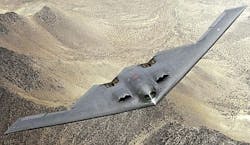Air Force scours industry for replacement part to nuclear bomber communications system
TINKER AIR FORCE BASE, Okla., 12 March 2013. U.S. Air Force aircraft communications experts are scouring industry to find companies able to build replacements for the obsolete CU-2421 antenna coupler for the AN/ARC-211 HF radio that Rockwell Collins in Cedar Rapids, Iowa, designed for the B-2 nuclear bomber aircraft.
Officials of the Air Force Materiel Command at Tinker Air Force Base, Okla., issued a source-sought notice last week (5985-01-368-8340) looking for companies able to replace the obsolete part for the B-2 communications HF radio system.
An antenna coupler essentially tunes an antenna to enable it to transmit and receive radio waves efficiently over a relatively wide frequency range. Without such a coupler to tune the antenna to many different frequencies, radios would require many different antennas to operate reliably.
The AN/ARC-211 radio was designed originally for the first versions of the B-2 bomber, which began fielding in the early 1990s. Since then various upgrades to the strategic bomber have installed high-speed data handling, EHF satellite communications, and other avionics improvements, but at least some of the aircraft still need the AN/ARC-211 HF radio.
Radios that operate on high-frequency (HF) bands between about 2 and 30 MHz rely on relatively long radio waves that bounce off the layer of the atmosphere called the ionosphere. The ability to bounce, or "skip" along layers of the atmosphere, gives the HF radio extremely long-range capability.
In the absence of satellite communications, HF radio could be the B-2's only method of contacting home bases or national command authorities while on distant missions. The ability to communicate reliably over long distances is essential for the B-2 because it can carry nuclear weapons.
So to find an acceptable replacement for the AN/ARC-211's obsolete CU-2421 antenna coupler, the Air Force is conducting a market survey to identify companies that could do the job.
Officials of the Air Force Materiel Command want to hear from companies able to furnish all required labor, expertise, facilities, and equipment to accomplish a CU-2421 antenna coupler obsolescence study, analysis, and solution recommendations.
Companies must have a quality system that meets the requirements of ISO9001:2008; possess all required technical data to perform the task; have previous history and technical knowledge of the item; and be familiar and have experience with form, fit, and function components, line replaceable units (LRUs), and shop replaceable units (SRUs) replacements.
Companies also must have previous history, technical knowledge, and experience working with hardness-critical items (HCIs), which have the ability to tolerate doses of radiation sufficient to operate through a nuclear explosion.
Companies interested should respond no later than 5 April 2013. For questions or concerns contact the Air Force Material Command by email at [email protected]. More information is online at https://www.fbo.gov/spg/USAF/AFMC/OCALCCC/5985-01-368-8340/listing.html.

